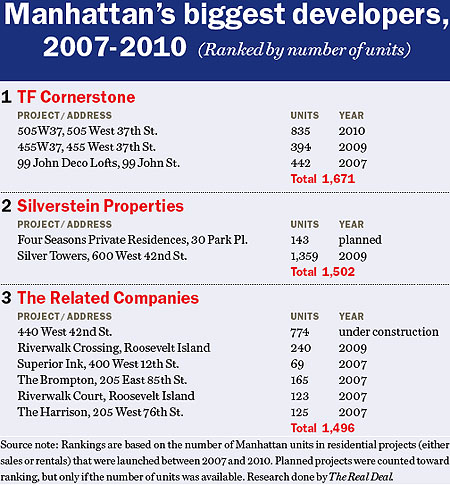Trending
Building through the slump
The Real Deal ranks the top 10 busiest developers in recent years

Tom Elghanayan
The last few years have obviously been tough for New York City
developers, but that hasn’t stopped a number of them from seeing their
boom-time projects through — without falling into foreclosure.
Some have even taken the bold step of planning for new projects,
banking on the fact that by the time their new towers are erected and
ready to be sold (or rented), the market will be in better shape than
it is now.
This month, The Real Deal looked at the top 10 developers in
the city who’ve started sales or leasing of new Manhattan residential
projects, or announced plans to build new developments during the
downturn, over the course of the last three and a half years.
At the top of the list is TF Cornerstone, which between 2007 and 2010
has delivered 1,860 units to Manhattan’s residential market in three
buildings — 505 and 455 West 37th Street, 201 Pearl Street and 99 John
Street.
Like most of the firms on the list, TF Cornerstone — which split
off from Rockrose Development last year and took two-thirds of the
company’s portfolio with it — has bet heavily on the Far West Side and
on Lower Manhattan.
TF Cornerstone’s chairman, Tom Elghanayan, said the firm pays an
average of 25 percent of development costs, whereas less-capitalized
developers have been known to put in as little as zero when banks were
being more generous.
“We’ve always been conservative,” said Elghanayan, who runs the
firm with his brother Frederick. “We’ve never overleveraged and have no
mezzanine debt.”
Still, renting and selling condos in this market isn’t easy.
At 505 West 37th Street, TF Cornerstone’s newest property, the
company has had to lower rents in its buildings to lure tenants, and
it’s still offering a free month’s rent. That’s despite the fact that
many rental buildings have recently stopped offering that concession.
While those discounts would seem to hurt the firm’s bottom line,
Elghanayan said the buildings still work out from a financial
perspective. “Yes, rents went down dramatically in our buildings, but
the result was still positive because of our margin of error,” he said.
The other firms rounding out the top five on The Real Deal‘s
survey of biggest downturn developers included Silverstein Properties
with 1,502 units, the Related Companies with 1,496, Metro Loft
Management with 1,120 and Glenwood Management with 965 units.
Silverstein’s Silver Towers, which is on 42nd and 11th Avenue, hit
the market last year with a stunning 1,359 luxury rental units. With a
playground, pool and concierge, the project is one of several buildings
reshaping a stretch once devoid of luxury residential housing. Studios
start at $2,575 there, according to the complex’s website. Cliff Finn,
who is handling the rentals for Citi Habitats, did not return calls for
comment about lease-up rates.
But while it may seem like opening a rental in a depressed
ownership market is a shrewd calculation, some brokers caution from
reading too much into it.
“New York is a complex place to get a residential deal done. It’s a
time-consuming, multiyear process,” said Doug Harmon, a senior managing
director with Eastdil Secured who handles commercial transactions, like
the sale of the Upper West Side’s Apthorp. “A lot of the projects were
conceived in the boom times.”
Presumably that diagnosis would also apply to Harmon’s own home in
Superior Ink, a 69-unit West Village development from Related. The
project is one of five in Manhattan that Related has delivered since
2007.
Others include the 165-unit Brompton on the Upper East Side and the
125-unit Harrison on the Upper West Side, both of which are 90 percent
sold, according to a Related spokesperson, though some buyers demanded
deposits back over design and construction problems. But Related, which
also churned out rentals like Riverwalk Court and Riverwalk Crossing on
Roosevelt Island, is forging ahead with another huge project, a nearly
800-unit mixed-used tower with both condos and rentals, including
affordable units, under construction at 440 West 42nd Street.
While there are exceptions, most of the units built by the top
developers during the last three and a half years were rentals, in a
fortuitous turn.
Meanwhile, many of the projects that developers have recently
completed are enormous. That stands in contrast to the projects on the
survey the last time it was published, which covered 2003 to 2007. At
that time there were far more projects with fewer than 500 units than
there are today.
Metro Loft Management, which ranked fourth on this year’s list, for
example, is packing some 800 units into its 20 Exchange Place, a 1931
former bank that used to be one of the world’s tallest buildings. The
building started renting in 2008, and as of the middle of last month,
14 units were available in the building, with studios starting at
$1,886.
And Emerald Green and Barclay Towers, which contain 569 and 396
units, respectively, helped Glenwood Management secure fifth place.
One-bedrooms at Emerald Green, which is located at 320 West 38th
Street, start at $3,495, according to its website.
Many of the behemoths on The Real Deal‘s lists are in former industrial zones.
The hulking ziggurat known as Clinton Park, with 900 apartments,
is, for example, rising on 11th Avenue, where car dealerships rule. The
project is so large that it landed developer Two Trees, which had no
other Manhattan projects between 2007 and 2010, in sixth place on the list. (Two Trees builds almost exclusively in Brooklyn.)
The upside to a downturn is that land costs drop, from about $500 a
foot in Lower Manhattan in 2007 to about $300 today. But even if a
developer is sitting on an empty plot, “it’s easier to get financing to
convert existing buildings than to build new ones,” said broker James
Nelson, a partner with Massey Knakal.
That might explain why the Moinian Group has delayed a huge
apartment building once planned for a parcel at 605 West 42nd Street.
Jason Gohari, a Moinian associate director, didn’t return calls for
comment for this story, but the Moinian Group said in 2008 that the
building would be completed this year. A current rendering at the site
also shows a much smaller building.
Still, Moinian has been active, with 666 units in a pair of
buildings — Dwell95 and the Downtown W — to earn it seventh place.
Only Extell Development, in eighth, scattered its apartments among
numerous towers, with 110 in the Lucida and 260 in 212 East 47th
Street, for instance, both of which are condos. Meanwhile, in a bold
move, company president Gary Barnett announced last month plans to
build the largest residential tower in Manhattan on a two-block parcel
on West 57th Street. The proposal, the first major new construction
project announced since Lehman Brothers fell in 2008, calls for a 3
million-square-foot building with 136 residential units and a 210-room
hotel.
For Kelly Kennedy Mack, president of the Corcoran Sunshine
Marketing Group, which specializes in new condos, the idea of a
ground-up project of this scale is an encouraging macroeconomic sign.
“I think it signifies that new development is back,” says Mack, adding
that “we’re seeing interest in properties that were stalled, about
bringing those properties to market.”
Milstein Properties, which hibernated during the boom, awoke in
2009 to break ground on Battery Park City’s last two parcels — condos
Liberty Luxe, with 280 units, and Liberty Green, with 191.
Jeff Levine, the chairman of Douglaston Development, which ranked
10th, said dropping prices has been essential to surviving the
downturn. At his 21-unit Zinc building, which debuted at 475 Greenwich
Street in Tribeca in 2007, for example, ‘we were very aggressive in our
price points, selling for $1,300 a foot, though a similar-quality
product might have been $1,400 or $1,500,’ Levine said.
building, which debuted at 475 Greenwich Street in Tribeca in
2007, for example, “we were very aggressive in our price points,
selling for $1,300 a foot, though a similar-quality product might have
been $1,400 or $1,500,” Levine said.
And low-interest bond financing was critical at the Ohm, a 369-unit
rental at 312 11th Avenue that’s 50 percent leased in four months, said
Levine, who’s offering two months of free rent and paying brokers’
commissions. “We like to think that in good markets and bad, projects
that are well conceived will prosper,” he said.
Some faces are notably absent from the top-ten list, like
Boymelgreen Developers and Swig Equities, which were flying high in
2007. Boymelgreen had an acrimonious split with partner Lev Leviev in
2007, not to mention a flurry of lawsuits about construction defects.
Swig, meanwhile, also found himself in a nasty spat with a partner,
Yair Levy, on top of various lawsuits. Levy was also on the previous
top-ten list.
Less obvious is what happened to Rose Associates, a longtime
Manhattan firm whose last major project was 2006’s 323-unit Chelsea
Landmark.
“Other developments weren’t economically viable to go forward,”
said Bob Scaglion, a Rose senior managing director, “but I’m sure they
will be viable in the near future.” Chief among those might be
CitiPoint, the 900-apartment complex planned for Downtown Brooklyn now
on hold.
Meanwhile, Rose is selling its know-how to landlords of troubled
properties; it’s now managing Harlem’s Riverton Square on behalf of new
owner CWCapital Asset Management. “But we look forward to building
again in an appreciative market,” Scaglion added.





